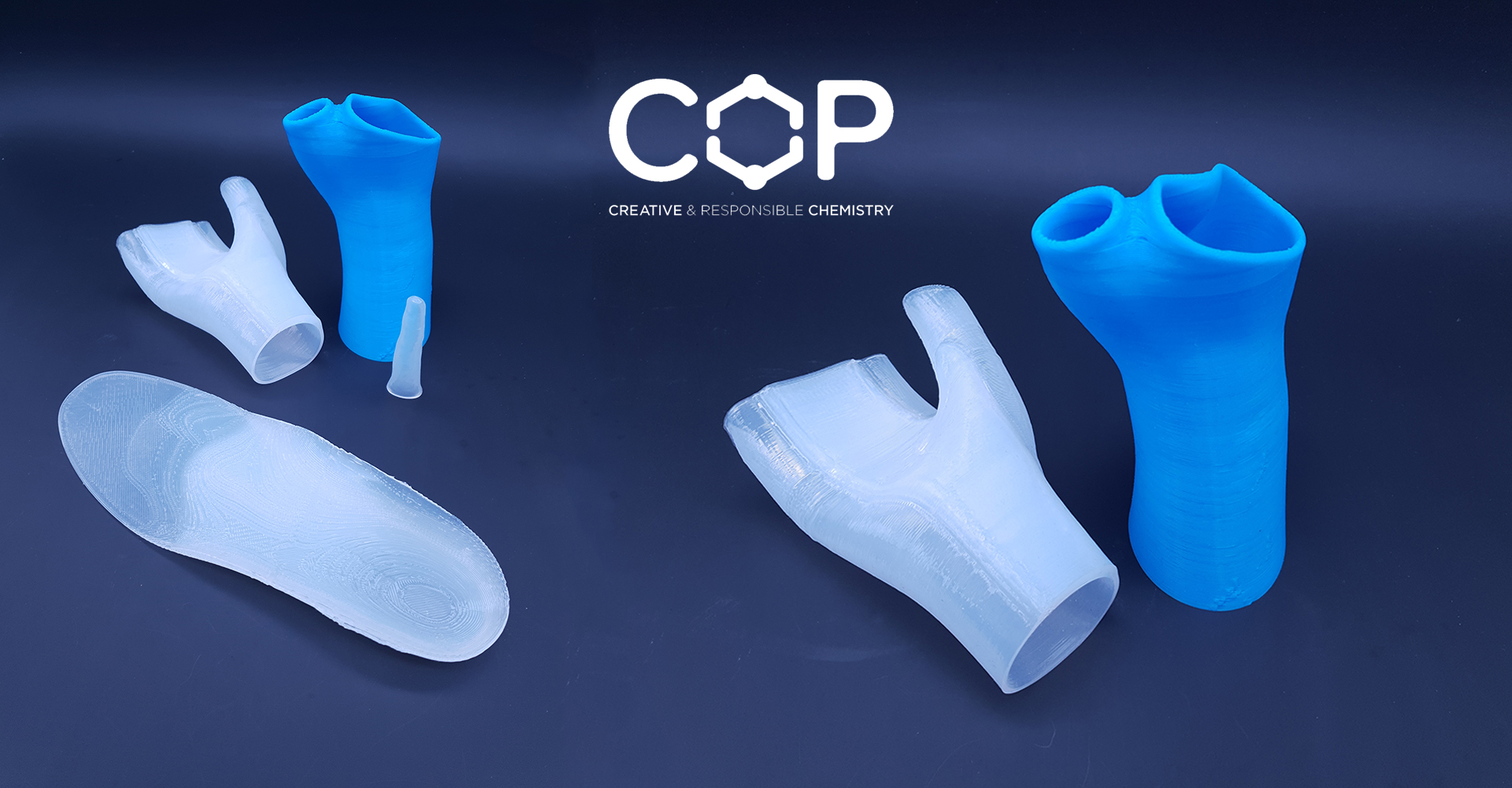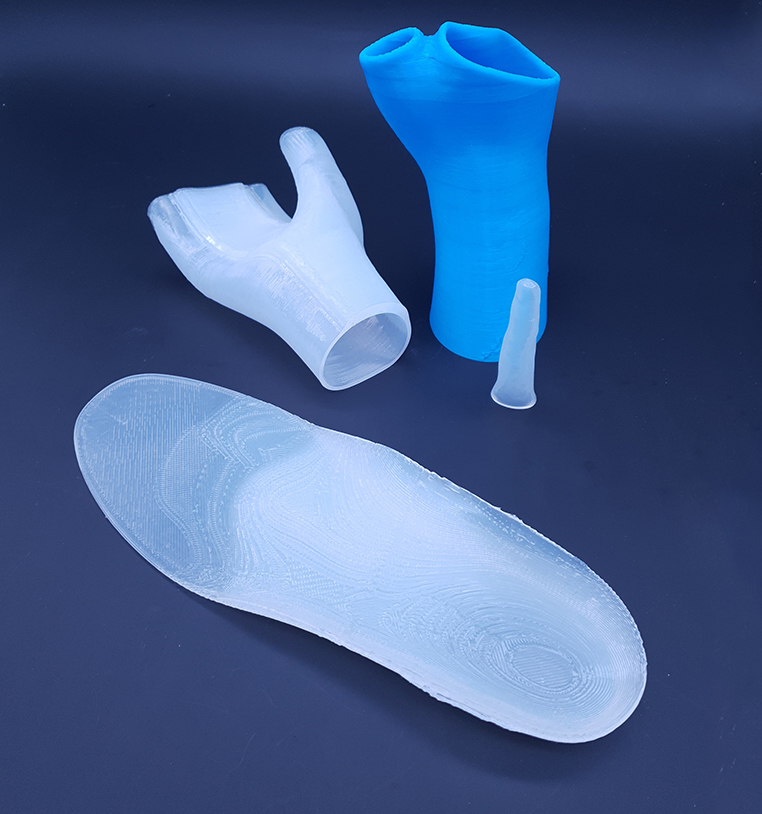COP Chimie’s sustainable chemistry: silicone 3D printing for orthopedic devices

Why did you focus your development on the 3D printing of soft materials?
As a prosthetist-orthotist by training, the idea came to me in 2013 when I returned from a congress organized by the FATO (African Federation of Orthopedic Technologists) in Yamoussoukro, Ivory Coast. I realized how difficult it was to bring certain polymer materials and technologies to African prosthetist-orthotists, even though they were in great demand.
Orthopedics is the art of imitating, adapting, or completing the human body to compensate for a physical handicap (malformation, amputation, palsy, etc.). The vast majority of orthopedic devices are made to measure.
Orthopedics work at two speeds: that of the developed Western countries which have access to the latest technologies, and that of the emerging countries where access to these technologies is more complicated. Indeed, their workshops do not always have the right equipment, training, or distribution networks to use the technologies.
In the 1980s, when my parents founded COP, we already saw a technological shift in materials. Leather, wood, and metal were replaced by polymers, which made it possible to improve the fit of orthopedic appliances, making them lighter, more comfortable, and therefore better tolerated by patients.
For over ten years now, we have been witnessing a new technological shift with the arrival of digital technologies. Today, it is possible to digitize the morphology of patients (via digital scanners) in order to mill the molds needed to make prostheses or orthoses.
3D printing also now makes it possible to eliminate the mold manufacturing stage and to go directly from the digitization of patients to the modeling and printing of orthopedic devices. It is a technology that allows the production chain to be shortened, saving time and resources with an optimized consumption of materials and much less non-recyclable waste.
Additive manufacturing (AM) is therefore a technology that simplifies processes, does not eliminate the know-how of professionals, and makes sense in regions of the world where workshops are sometimes under-equipped.

The orthopedic field has to face financial, operational, and adaptation constraints in order to provide patients with an optimal device. How can the use of silicone for 3D printing help to overcome these constraints?
Traditionally, silicones are presented in liquid form and require extra tooling (molds, counter-molds) to be shaped. This represents a large part of the budget for the production of a single device. It’s also quite time-consuming for the manufacturer as well as for the patient, who must sometimes travel several times during their device’s manufacturing process for fittings.
However, silicones offer numerous advantages:
- they can easily be colored,
- offer resistance to high temperatures,
- are flexible,
- feature good hydrophobic and texturing properties,
- and boast great chemical stability, making them suitable for physiological environments.
There are several silicone technologies in orthopedics. Our printable silicones are part of the RTV2 platinum family, which allows us to obtain skin-contact silicones. They are also used for their flexibility and the comfort they provide without ever subsiding.
Silicone materials also have the advantage of being safe to use. That’s why COP has been heavily investing in R&D and industrial equipment for this chemistry, to guarantee autonomy and repeatability throughout the design and production chain of skin-contact silicone formulations.
The 3D printing of silicones allows the creation of different types of meshes, bringing new properties to the printed object: making parts more lightweight, varying their hardness, allowing better damping, adding anisotropy, improving their mechanical properties, etc.
Unlike traditional casting methods which are time-consuming and expensive, 3D printing allows us to work directly on the modeling phase and thus achieve faster prototyping and production of custom-made orthoses and prostheses.
COP claims to be a “sustainable chemistry” company; what does it mean and how does this translate into your products?
The orthopedic field raises both human and environmental issues.
We are positioned on a niche market in which our customers are primarily craftsmen. Their use of materials is manual, i.e. no industrial mass production, and some of these materials are dangerous (carcinogenic, mutagen, toxic to reproduction (CMR), flammable, explosive, allergenic, irritant, etc.).
Acrylic resins that have been used for over 30 years to manufacture certain composite parts, for example, are highly odorous, flammable, and are used with CMR hardeners.
To address this issue, we have been focusing our strategy on developing alternative, safer materials since 2012. In 2016, we designed, developed, and marketed a new generation of biocomposites: bio-based, non-CRM, low-odor, bisphenol-free epoxy resins with better mechanical properties than acrylics, in combination with natural flax or basalt fibers.
At COP Chimie, we invest more than 20% of our turnover each year in R&D, which represents ¼ of our innovative workforce within an integrated laboratory.
The next major challenges that we wish to take up converge on two major themes for chemistry that is more respectful of mankind and of the environment:
- the recyclability of materials used for making orthopedic devices
- the accessibility of 3D printing technologies for emerging countries.

